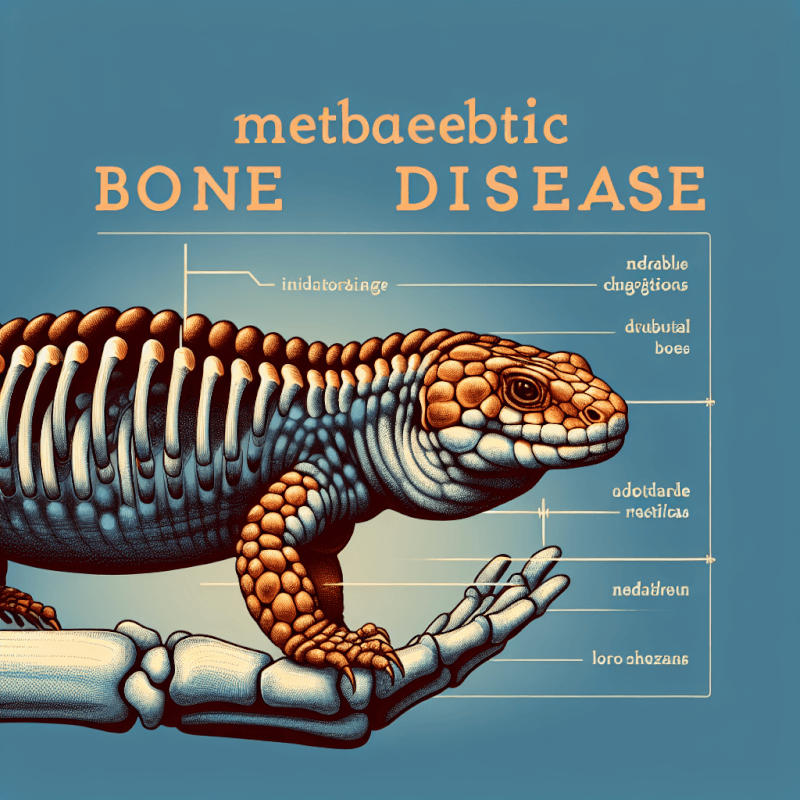Have you ever wondered how to identify metabolic bone disease in reptiles? It’s crucial to be able to recognize the signs of this common ailment in order to provide the necessary care for your scaly friend. In this article, we will explore the telltale signs of metabolic bone disease, helping you ensure the health and well-being of your reptile companion. From subtle behavior changes to visible physical symptoms, understanding these signs will allow you to intervene early and seek appropriate treatment. So, let’s dive into the world of reptile health and discover how to spot metabolic bone disease!
Overview of Metabolic Bone Disease
Metabolic Bone Disease (MBD) is a common condition that affects many reptiles. It is a disorder of the bones, where the bones become weak and brittle due to a variety of factors. Without intervention and proper treatment, MBD can have serious consequences for the overall health and well-being of reptiles. It is crucial for reptile owners to be aware of the causes, signs, and treatment options for MBD in order to ensure the optimal care of their beloved pets.
Causes of Metabolic Bone Disease
There are several potential causes of Metabolic Bone Disease in reptiles. It is important to understand these causes to prevent the development of MBD in your pet.
Imbalanced Calcium-To-Phosphorus Ratio
One of the primary causes of MBD in reptiles is an imbalanced calcium-to-phosphorus ratio in their diet. Calcium and phosphorus work together to support healthy bone growth and development. If there is an excess of phosphorus or a deficiency of calcium, it can disrupt the normal bone metabolism, leading to the development of MBD.
Vitamin D Deficiency
Vitamin D plays a crucial role in calcium absorption and utilization in reptiles. Inadequate levels of vitamin D in their diet or a lack of exposure to natural sunlight can lead to Vitamin D deficiency, which in turn can contribute to the development of MBD.
Inadequate Exposure to UVB Light
Reptiles require UVB light exposure to synthesize Vitamin D3 in their skin, which is necessary for the absorption of calcium from their diet. Lack of access to UVB light or improper lighting setups can lead to Vitamin D deficiency and subsequently contribute to the development of MBD.

Common Reptiles Affected by Metabolic Bone Disease
Metabolic Bone Disease can affect various species of reptiles, but certain species are more prone to developing this condition due to their specific dietary and environmental requirements. Some of the reptiles commonly affected by MBD include:
Iguanas
Iguanas are herbivorous reptiles that require a high-calcium diet. Their susceptibility to MBD is often linked to inadequate calcium intake or an imbalanced calcium-to-phosphorus ratio in their diet.
Bearded Dragons
Bearded dragons, similar to iguanas, require a diet rich in calcium. Inadequate calcium intake or improper diet can lead to the development of MBD in these popular pet reptiles.
Chameleons
Chameleons have unique dietary and environmental needs. They require UVB lighting and a diet high in calcium-rich insects. Lack of UVB exposure or inadequate calcium intake can contribute to the development of MBD in these fascinating creatures.
Geckos
Geckos, such as leopard geckos and crested geckos, are also prone to MBD. They require a balanced calcium-to-phosphorus ratio in their diet and access to UVB light. Inadequate diet or incorrect lighting setups can lead to MBD in these reptiles.
Turtles and Tortoises
Turtles and tortoises require a varied and balanced diet to ensure proper bone health. Lack of essential nutrients, such as calcium and vitamin D, can contribute to the development of MBD in these reptiles.
Snakes
While snakes are not as commonly affected by MBD as other reptiles, it is still possible for them to develop this condition. Certain species of snakes with specific dietary or environmental needs may be at a higher risk of MBD if their needs are not properly met.
Physical Signs of Metabolic Bone Disease
Recognizing the physical signs of Metabolic Bone Disease in reptiles is crucial for early detection and intervention. The following are common physical signs that may indicate the presence of MBD in your reptile:
Stunted Growth
Reptiles with MBD often experience stunted growth. Their bones may not develop properly, leading to a smaller overall size than would be expected for their species and age.
Soft Shell
A soft or rubbery shell is a common symptom of MBD in turtles and tortoises. The shell may be pliable or appear deformed, indicating weakened bone structure.
Bowed or Twisted Limbs
Reptiles with MBD may have bowed or twisted limbs. The bones in their limbs become weak and may bend or deform. This can affect their ability to move and navigate their environment.
Swollen Jaw or Face
MBD can cause swelling in the jaw or face of reptiles. This can be a result of weakened bones or pressure from abnormal bone growth.
Limping or Reluctance to Move
Reptiles with MBD may exhibit limping or reluctance to move. The weakened bones can make movement painful or difficult for them.
Difficulty Shedding Skin
Metabolic Bone Disease can lead to difficulties in shedding skin properly. Reptiles may have pieces of retained shed or issues with shedding their skin completely due to weakened bones.
Abnormal Spinal Curvature
Another physical sign of MBD is an abnormal spinal curvature. The vertebrae can become malformed or misaligned, leading to a curved or hunched appearance.

Behavioral Signs of Metabolic Bone Disease
In addition to physical signs, there are also behavioral signs that may indicate the presence of Metabolic Bone Disease in reptiles. These signs can offer valuable insights into the overall health and well-being of your pet:
Decreased Appetite
Reptiles with MBD may exhibit a decreased appetite. They may have difficulty eating or lack interest in their usual food.
Lethargy
Lethargy or a decrease in activity levels can be a behavioral sign of MBD. Reptiles may appear sluggish or have a lack of energy.
Restlessness or Agitation
On the flip side, some reptiles with MBD may show restlessness or agitation. They may exhibit abnormal behaviors or engage in repetitive movements.
Excessive Drinking
Some reptiles with MBD may drink water excessively. This can be a sign of underlying metabolic imbalances or an attempt to compensate for the weakened bone structure.
Constipation or Diarrhea
Metabolic Bone Disease can also affect the digestive system of reptiles. They may experience constipation or diarrhea, which can be indicative of an underlying health issue.
Diagnosing Metabolic Bone Disease
If you suspect that your reptile may have Metabolic Bone Disease, it is crucial to seek veterinary attention for a proper diagnosis. The following diagnostic methods may be used to confirm the presence of MBD:
Physical Examination
A comprehensive physical examination will be conducted by a reptile veterinarian. They will examine your reptile’s body, limbs, shell, and other relevant areas to assess for any physical signs of MBD.
Radiographs or X-Rays
Radiographs or X-rays are commonly used to diagnose MBD in reptiles. These imaging techniques allow the veterinarian to assess the internal bone structure and identify any abnormalities or signs of bone demineralization.
Blood Tests
Blood tests may be conducted to assess the levels of calcium, phosphorus, and vitamin D in your reptile’s blood. These tests can help confirm a diagnosis of MBD and identify any underlying metabolic imbalances.

Preventing Metabolic Bone Disease
Prevention is key when it comes to Metabolic Bone Disease in reptiles. By implementing the following preventive measures, you can reduce the risk of your reptile developing MBD:
Optimal Diet
Ensure that your reptile’s diet is nutritionally balanced and appropriate for their species. Consult with a reptile veterinarian or a knowledgeable reptile specialist to determine the best diet for your pet.
Proper Calcium-to-Phosphorus Ratio
Maintaining a proper calcium-to-phosphorus ratio is crucial for preventing MBD. Provide calcium-rich foods and supplements as recommended for your reptile’s specific dietary needs.
Providing UVB Light
Ensure that your reptile has access to appropriate UVB lighting. UVB light is necessary for reptiles to synthesize Vitamin D3 and absorb calcium from their diet. Consult with a reptile specialist to determine the optimal lighting setup for your pet.
Monitoring Vitamin Levels
Regularly monitor the vitamin levels in your reptile’s diet. Vitamin D is particularly important in preventing MBD, so ensure that your pet is receiving adequate levels of this essential nutrient.
Regular Vet Check-ups
Schedule regular check-ups with a reptile veterinarian to assess your pet’s overall health and monitor for any early signs of MBD. Early detection and intervention can make a significant difference in the outcome for reptiles with MBD.
Treating Metabolic Bone Disease
If your reptile is diagnosed with Metabolic Bone Disease, the following treatment options may be recommended by a reptile veterinarian:
Dietary Changes
A balanced and appropriate diet will be crucial for the recovery and management of Metabolic Bone Disease. The veterinarian may recommend specific dietary changes to ensure that your reptile is receiving the necessary nutrients for bone health.
Calcium and Vitamin D Supplements
Supplementing with calcium and Vitamin D may be necessary for reptiles with MBD. The veterinarian will advise on the appropriate dosage and administration methods for these supplements.
UVB Light Therapy
Reptiles with MBD will benefit from increased exposure to proper UVB lighting. The veterinarian may recommend specific UVB light therapy protocols to help improve Vitamin D synthesis and calcium absorption.
Corrective Surgery
In severe cases of MBD, corrective surgery may be required to address deformities or abnormalities in the bone structure. Surgery may be necessary to realign bones or stabilize fractures.

Lifestyle Adjustments for Reptiles with Metabolic Bone Disease
Making certain lifestyle adjustments can greatly assist in the management and overall well-being of reptiles with MBD. Consider implementing the following adjustments:
Improved Enclosure Setup
Ensure that your reptile’s enclosure is properly set up to meet their specific environmental needs. This includes providing appropriate hide spots, climbing structures, and sufficient space for your pet to move and exercise.
Temperature and Humidity Control
Maintaining appropriate temperature and humidity levels in the enclosure is crucial for reptiles with MBD. Consult with a reptile specialist to determine the optimal temperature and humidity range for your specific reptile species.
Providing Adequate Basking Spots
Basking spots are essential for reptiles to thermoregulate and absorb heat. Ensure that your reptile’s enclosure has appropriate basking spots with sufficient heat and UVB exposure.
Encouraging Exercise
Regular exercise is important for maintaining muscle tone and overall health in reptiles. Provide opportunities for your pet to climb, explore, and engage in natural behaviors.
Minimizing Stress
Reducing stress levels is crucial for reptiles with MBD. Avoid unnecessary handling or disturbances, provide a quiet and calm environment, and ensure that the enclosure is adequately enriched to meet your pet’s behavioral needs.
Fluid Therapy
In some cases, reptiles with MBD may require fluid therapy to address dehydration or imbalances in their electrolyte levels. Consult with a reptile veterinarian for guidance on proper fluid therapy protocols if necessary.
Conclusion
Metabolic Bone Disease is a serious condition that can significantly impact the health and well-being of reptiles. By understanding the causes, signs, and treatment options for MBD, you can take proactive measures to prevent its development and ensure the optimal care of your reptile companion. Regular veterinary check-ups, a balanced diet, appropriate UVB lighting, and a suitable enclosure setup are all crucial aspects of preventing and managing Metabolic Bone Disease in reptiles. With proper care and attention, you can help your reptile live a long, healthy, and happy life.



